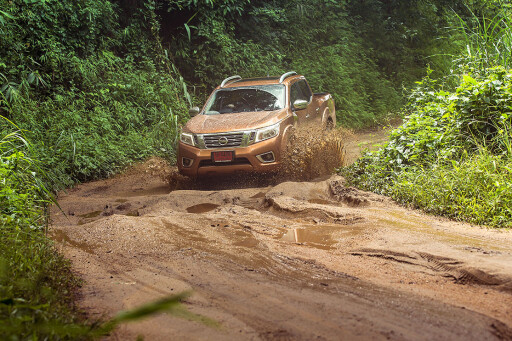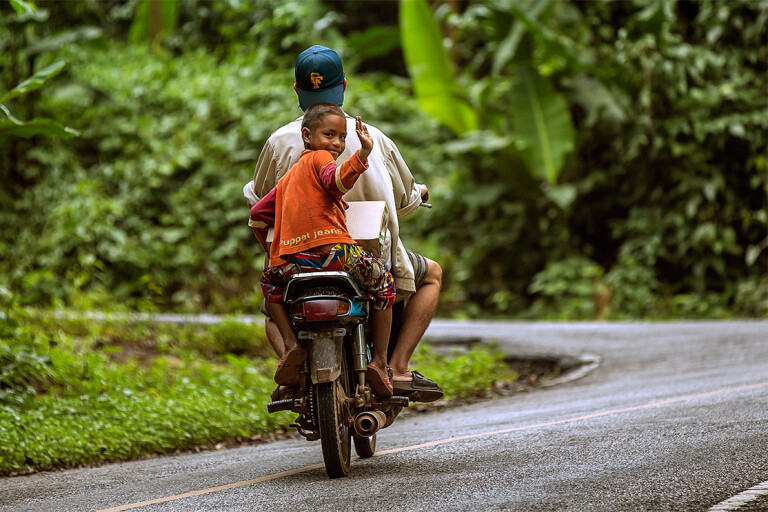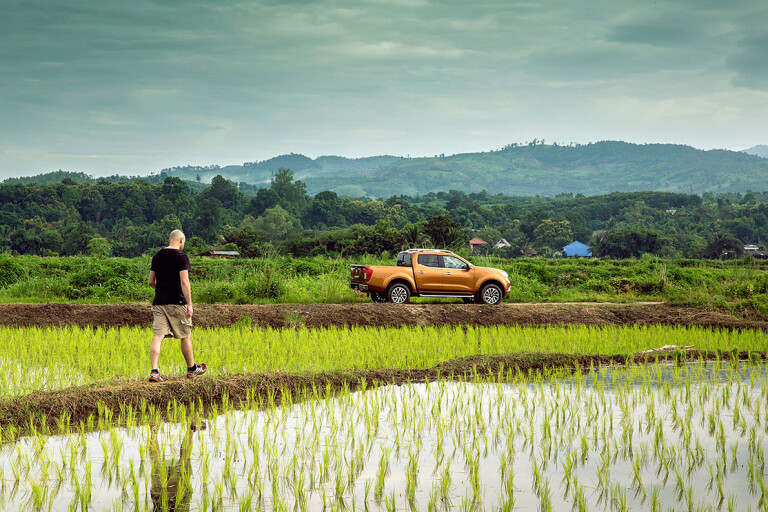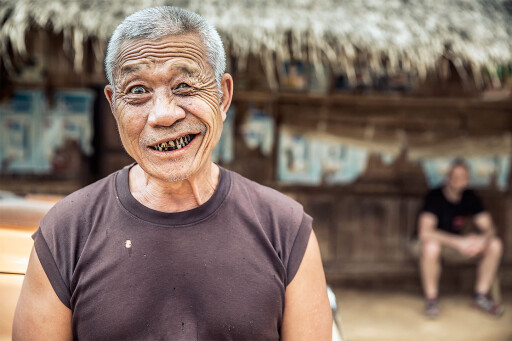
WE’RE lost, deep in the jungles of the Golden Triangle, rattling and rolling along a dark and creepy twisting Thai road that looks like it hasn’t been used for years. There’s moss on the moist surface and some plants have broken through the seemingly porous tarmac in places. Have we crossed into the lawless hills of Burma? Or are we still on the northern tip of Thailand?
I’m nervous, and with good reason. The Golden Triangle is not a deluxe percussion instrument, but an area encompassing the top of Thailand, the fringes of impoverished Laos and a wedge of secretive Burma. The reason it’s ringing a vague bell (or triangle) in your head is that it’s been famous as the production hub for truckloads of opium poppies and near-pure heroin since its heyday in the 1960s.
Back then, the CIA turned a blind eye because the drug lords controlled most of the hill tribes who were fighting communists on its behalf, and cheap guerrillas don’t come along every day. This deal with the devil led to more than one-third of Americans fighting in Vietnam succumbing to addiction by 1971, before Golden Triangle heroin flooded the US, causing untold misery.
Thailand has since largely cleaned up its act and has a low-tolerance attitude to drugs, but heroin is still produced in massive quantities just across its borders.

Credit (all pictures): Nathan Duff.
We round a bend and a man steps out with a large assault rifle. This isn’t the sort of thing you see very often in country Queensland, which is where my nervous and sweating snapper, Nathan Duff, is from. “Reckon we should turn around?” I ask, and he agrees with wordless, gurning enthusiasm.
I chuck our new Nissan Navara into a quick and clumsy seven-point U-turn under the glaring stare of the border guard. A hasty retreat it is not, but a wise one certainly.
We’re in Thailand to drive the next-generation Nissan hauler because this is where they are built, along with most of the other big utes that now outsell most passenger cars in Australia. This one, codenamed D23, lands in Australian dealerships about the middle of 2015 as the Navara NP300.
It makes sense to produce them in Thailand given the average annual income here is only about $3200, but there is another reason. Tough utes such as the Navara, Ford Ranger, Toyota HiLux and Isuzu D-Max are immensely popular in Thailand, both in the cities and out here among the rice paddies.
The utes sold in Thailand have much harder lives than the pampered one-tonners that make it to Australia. Here, stacking your ute with an outrageous load is not just about logistics, it’s a matter of honour. The maximum payload figure is just a starting point, and something whip-thin Thai blokes probably chortle about as they throw another bag of rice in the tray.
If you visit Thailand, be prepared to be astonished by audacious local drivers happy to limp along at half the speed limit as their vehicles wobble and groan (the only things they overload with even more enthusiasm are motor scooters).

But the work ute’s steel tubs are not only for carrying masses of inanimate objects. No, Thai utes double as people-movers. We see one overflowing with 12 kids. Another appears to have a regular load covered by a tarpaulin to protect it from the heavy rain that has just been unleashed from the thick clouds above. As we approach, I notice a little girl’s head poking out, and then those of her siblings and her mum. They look miserable.
It seems wrong that we are driving a massive crew-cab with vacant seats and this family is out in the rain, but this is Thailand. The kids might actually be grateful they are not being carried on a scooter, copping continuous spray like many other kids, including newborns. Some mothers carry a small child, hold an umbrella and steer at the same time.
Our journey started out before dawn in Chiang Mai, which used to be the funnel-end of the drug trade at its peak. These days, the city is known for its many elephant parks, which lure tourists by the thousands. Just down the road, we pass a line of the giant and majestic beasts loping along carrying tourists perched on steel platforms. Some passengers appear ecstatic, while others are just over it, sick of the damn swaying.
The ride is much more composed in the Navara. Nissan has taken the bold step of ditching the rear leaf springs and replacing them with a five-link system using coil springs. It says the switch adds cost, but does not affect the payload, which will be more than 1000kg for all Australian models.
The suspension gets a workout today on roads that could generously be described as adequate, with a light sprinkling of craters. Thankfully, the Navara’s suspension tune has always been on the soft side and it is the same with this generation. This American luxury-sedan level of suppleness might not assist handling, but it helps absorb the chaos of the potholes.

We press north and crest a hill at about 110km/h only to find a full-size Volvo tanker truck approaching in the opposite lane, which would be fine except there’s another tanker truck passing it, in our lane. With no time to scream, I swerve across into the emergency lane, which in Thailand is mostly considered an overflow lane, to avoid a face full of truck.
“Did that just happen?” I ask Nathan, attempting and failing to sound unflustered. “Yes,” he says. “Yes, it did.” His eyes have doubled in size.
Traffic manoeuvres that would be considered completely nuts (and very much illegal) in Australia are just a way of life here. Traffic lights are mere colourful decorations to some drivers, to be obeyed with roughly the reverence given to advice from your parents. A ‘green man’ pedestrian signal is more of a dare than a promise of a safe crossing.
That said, there is no road rage. I hear just one horn honk in 642km of driving, which comes from a truck I zip across in front of to make a turn. The driver just wants to let me know he’s there and that he’s no chance of stopping for me. As he careers past, I noticed that among his cargo is an elephant. Of course there is.
The Navara is not a natural choice for the kind of traffic you cop anywhere near a Thai city, especially a six-speed manual version. Fortunately modern workhorses are far more civilised than those of old.
This one has a light clutch and the smallish 2.3-litre four-cylinder turbo-diesel engine can walk away from a stop with minimum revs, which means no stalls or slipping the clutch. The manual shift is passenger-car quality and isn’t notchy at all.
You can also get a seven-speed automatic, which makes life even easier, but it has been tuned for economy and annoyingly selects the highest gear possible, as soon as possible, which generates a deep harmonic that is one of the most annoying sounds known to man as the engine lugs along doing 1200rpm or even less.

We pull off the main road instinctively when I spot a sign that reads “Long Neck Karen”. I don’t know who Karen is, but I could go a bottle of beer in this heavy tropical heat. It turns out there are no large bottles of beer because the sign was pointing to a village of Karen people, a displaced ethnic minority from Burma, some of whom wear traditional long gold neck bands. The women’s necks don’t actually grow longer, but the weight can push down their shoulders to make it look that way.
There is a definite whiff of exploitation in the ‘village’, which has a $10 entry fee, but I’m told the Karen have no legal status in Thailand and no access to state medical care, so they need the money. I buy a bad scarf, which looks imported, head back for the ute and start the engine.
While it sounds loud in a quiet village, the Renault-developed unit is more refined than many commercial diesels and makes the same amount of power and torque as the existing D40 engine, but is 200cc smaller. There are two turbos – one big and one small – that feed the four cylinders, and it all seems to work extremely well, at least with no cargo on board.
The engine is particularly strong at low revs, which means you can pick a taller gear and let it pull, but now it’s time to start changing down as we arrive at a checkpoint set up to look for drugs. We go through no fewer than 10 of these on our trip north and are stopped six times by officers with big, scary guns, cautious of two white devils driving an empty ute into heroin country.

Thailand is currently under military rule after a bloodless coup in May, so I expected some presence, but these roadblocks pre-date the takeover. Fortunately we don’t have anything to hide, so after a few questions we are bid farewell with handshakes and big smiles.
We take a turn off and head into the hills of Tha Ton, eventually pulling into a service station for fuel. This servo is supposedly owned by Lao Ta Saenlee, a man who led an army of 700 locals against communist forces in return for land in a deal with US-friendly Thai authorities in the 1960s and 70s.
The regime in Bangkok recently labelled him a drug lord and accused him of carrying out a 400kg heroin deal. The charge was thrown out, but he did four years for possessing a cache of weapons. Lao Ta claims he has nothing to do with drugs these days, despite admitting to trading opium for guns many decades ago.
The 77-year-old now runs a series of coffee shops across the region, and this petrol station, where we find him lying on the forecourt getting a massage. The fuel business must be slow. I walk past him to pay, and notice the guy doing the massaging is a completely ripped Muay Thai fighter type who appears to be channelling all his strength to the old man’s leg muscles.
We ease out the driveway and head for the border, near the Burmese town of Tachileik, which was the main point for bringing in the gear from the nearby heroin-production facilities the CIA reportedly ignored. The drug lords may still use the main border crossing, but the nearby Mekong River is apparently a key transport route. Not far from here, the bodies of 13 Chinese sailors were found floating down the river in 2011, in what authorities think was a deal gone sour.

We find one of many Buddhist temples, which are beautiful and tranquil. It is lovely here, apart from the blood-curdling screeching coming from the dense jungle. I think they are insects; at least I hope they are. Should they tire of the jungle life, they could always head to Hollywood and work on horror movie soundtracks.
The sun starts to set as we depart on the return trip and prepare ourselves for several more drug searches, but the first checkpoint is curiously empty, as is the next and, inexplicably, every single one after that.
Really, I thought that after a day on the road in Thailand I had lost the ability to be shocked, but I was wrong. For all the War on Drugs rhetoric, we could have sailed back down from Poppy Land with an actual tonne of heroin in the tray, smoking a giant reefer and driving on the wrong side of the road with Hits From the Bong blaring through the speakers and still not been picked up.
Instead, the fact that we are empty means we can enjoy some of the wonderful, windy roads on the way back to Chiang Mai, and the big Navara turns out to be kind of fun, in its own wallowy way, and on one section I duel with a pack of one-tonne utes travelling unloaded and at pace.
I lose myself in the moment and overtake three-wide, on the wrong side of the road, approaching a corner. It’s a stupid, risky move, but seems perfectly normal after a day in this traffic. I’ve always found it funny how seemingly sane people do crazy things in Thailand, things they would never do at home, like riding scooters wearing nothing but a pair of footy shorts.
However, I understand now; the risk-taking is contagious. But I guess of all the habits you could pick up in Thailand, it could be a lot worse.
MEET YOUR CAR MAKER
THAILAND is an increasingly popular location for building vehicles at low cost, but Nissan has been making cars there since 1963. Back then it built just four cars a day.
Australia has sourced the departing Navara from Spain and Thailand, but the new ute will come solely from our near northern neighbour. It will be built at a brand new factory in an outer suburb of Bangkok that lifts Nissan’s Thai capacity to 370,000 a year.
Currently, Nissan Australia sells both the D40 Navara and the previous-generation D22, but only the new D23 model will be available from early next year.
This article was originally published in Wheels November 2014.
COMMENTS